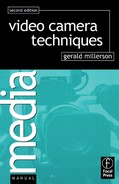Most cameras can be operated either –
• By adjusting various controls manually to suit shooting conditions,
• Or relying on the camera’s automatic controls to make corrections. Each method has its advantages and drawbacks, and you learn with experience which is most likely to produce the best results at any time. In most cases, you can choose whichever technique is preferable.
There are several systems and design variants. When working under difficult conditions, they can be more reliable than a human operator. At worst, they can even prevent you from taking the shots you want!
Typical automatic camera controls include:
Motorized zoom | Auto-focus |
Auto-exposure | Automatic gain control (AGC) |
Automatic white balance | Automatic black balance |
Automatic gamma | Automatic image stabilizer |
Instead of operating the zoom control by hand, you can press a switch, and have the lens zoom in/out automatically. The speed of the zoom motor varies with the pressure you put on a rocker switch, or the setting of a pre-set zoom rate control. The result is a smooth even action, that may be difficult to achieve by hand. However, manual zooming allows you to make subtle corrections in framing; e.g. expanding/contracting the coverage of a group shot as people enter and exit from it. When zooming manually to follow movement, it is much easier to compensate for the unexpected, than when using a motorized zoom.
I.R. systems – The camera sends a small beam of infra-red light, which reflects from the subject onto a sensor. The time taken to travel is measured, and interpreted as the subject distance. This system’s reaction time is slow (1.5 to 3 secs), but it works well in low light conditions. However, its range is limited, and the subject must be center frame. Due to false reflections, it is unreliable for subjects beyond glass, water, etc.
Piezo systems – A reflected signal from a tiny piezo-electric element controls a motor which re-adjusts the lens for the sharpest picture signal. On the viewfinder screen, a series of rectangles show which part of the shot you have selected to focus on. A rapid system, least confused by difficult subjects, it can focus accurately down to extremely short distances.
Digital A.I. systems – Here a vibrating piezo element within the lens adjusts focus, controlled by artificial intelligence circuits.
Auto-tracking systems – Another piezo system, which locks onto the subject, maintaining focus wherever it moves within the frame.
Contrast control system – Focusing self-adjusts until subjects within a selected zone of the viewfinder are focused for maximum brightness and contrast. Fuzzy logic systems search beyond this zone where necessary to find and sharpen a nearly-focused area.
Different auto-focus systems can be fooled by certain situations:
• Subjects behind glass, foliage, bars/netting, fences, etc.
• Smooth highly reflective subjects (glossy, curved, metallic).
• Low contrast subjects (plain-toned).
• Very dark subjects (light absorbent).
• Certain patterns (stripes – slanting or horizontal).
• When using various lens filters for special effects.
• Fast moving subjects.
• Weather conditions (e.g. rain, snow, fog).
• Dim lighting.
Auto-exposure control (auto-iris)
The design of this control varies between camera systems. Basically, it reads the brightness of the lens’s image falling onto the CCD, and re-sets the iris to keep it constant, so preventing over-exposure. Some auto-irises set both the lens aperture and the shutter speed when adjusting exposure. Some allow you to select a subject, then exposure-lock on it.
Most systems are mainly controlled by center-frame tones, but others have an upper-frame bias, to prevent bright skies from falsely reducing the exposure. Others assess all picture tones when adjusting exposure.
When shooting subjects against a bright background (e.g. sky), a backlight compensator can be switched in to avoid the iris closing excessively and producing a silhouette. This device opens the iris a little, but leaves the auto-iris circuitry in operation.
The main limitation of automatic exposure control systems, is that they can operate ‘irrationally’, changing whenever the picture-content alters. If you pan or zoom to include a lighter or darker area, the exposure changes for the entire picture including your main subject, which ideally should remain constant. As the iris fluctuates, face and background tones vary; depth of field changes.
Auto-iris has major advantages if you are moving around rapidly from sunny exteriors to shadowy interiors. It can compensate (however arbitrarily) for extreme changes in light level, producing very acceptable pictures where continual manual readjustments would be quite empirical!
